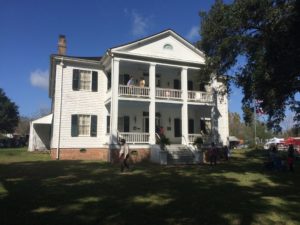Liendo Plantation is off U.S. 290 between Hempstead and Prairie View, and can be easy to miss if you’re not actively looking for it. Today it’s a working cattle ranch, but it has a fascinating history.
Liendo Plantion was established in 1853, less than a decade before the Civil War. It’s a Greek Revival home, and when it was built it was at the heart of an early Texas cotton plantation. The current owners have owned the home since 1960.
Some things you might not know about Liendo Plantation include:
1. A Civil War battle is reenacted there—but no battle was actually fought at the site.
Each year, Civil War enthusiasts meet at Liendo Plantation to reenact a Civil War battle. Participants wear authentic uniforms, with people watching the reenactment from a nearby grandstand (or, if they planned ahead, from the comfort of their lawn chairs).
The reenactment makes for an interesting display, but Liendo Plantation never served as a site for a real Civil War battle. It did, however, host cavalry and infantry training camps, and it also served as internment camp and a hospital.
2. Sam Houston was a frequent guest.
Sam Houston frequently stayed at Liendo Plantation while on his travels around Texas. He was there so often, in fact, that the second-floor room in which he would stay was named after him.
3. General George A. Custer was among Liendo Plantations’s famous guests.
Following the Civil War, General George A. Custer was stationed at Liendo Plantation. His wife, Elizabeth, joined him, and they apparently were very impressed with the area.
Custer would go on to meet his fate in 1876 at the Battle of Little Big Horn.
4. It was once home to a famous sculptress—although her studio was 110 miles away.
The sculptress Elisabet Ney (1833-1907) earned her place in Texas history by creating statues of those who made Texas history. Perhaps the most notable of her works are the statues of Sam Houston and Stephen F. Austin, which are on display in the south foyer of the state Capitol in Austin and reproduced in the Statuary Hall of the U.S. Capitol in Washington.
Miss Ney was from Germany. She married Edmund Montgomery, a physician, and they moved to America in 1871, and to Texas in 1873. The Liendo Plantation was their home (both would eventually be buried there after their deaths), but Miss Ney became unhappy at Liendo, missing the arts and intellectual stimulation that she craved. She purchased land in Austin and created a studio, which became known as Formosa.
Today both Liendo Plantation and Formosa are museums that are open to the public.

